Robert Motherwell Untitled (Black Ochre Pink) 1977-79 acrylic on canvas 20 x 30 in. (50.8 x 76.2 cm.) Signed and dated "R. Motherwell 1979" on the reverse.
Provenance Dedalus Foundation Ameringer & Yohe Fine Art, New York Sotheby’s, New York, Contemporary Art, September 10, 2008, lot 96 Acquired at the above sale by the present owner Literature J. Flam, K. Rogers and T. Clifford, Robert Motherwell A Catalogue Raisonné, 1941-1991, vol. 2, Paintings on Canvas and Panel, New Haven: Yale University Press, 2012, cat. no P977, p. 476 (illustrated) Catalogue Essay “I would say that in that sense there are certain colors that have become my colors; they’re yellow ochre, black and white, and so on. Colors are no different than shapes. Anybody recognizes a Tanguy shape, or a Magritte shape, or a Miró shape. Well, one has to use color as personally and as exactly as one does shapes.” ROBERT MOTHERWELL 1971 A major figure of the Abstract Expressionist generation, Robert Motherwell entered into what is considered to be one of the most important periods of painting in art history during a time that would ultimately change the face of American painting. Influenced by Surrealism, this young group of artists, including Jackson Pollock and Mark Rothko renounced the commonplace realist style prevalent at the time as they believed it only scratched the surface of American culture. Instead, their interests laid in examining a broadened and less palpable truth that existed beyond easily recognizable imagery. Thus, the Abstract Expressionists made it their goal to create work that depicted an accumulation of emotional truth, authenticity, and the freedom associated with postwar life in the United States. Motherwell was the youngest and one of the most prolific figures of the group, playing a significant role in the intellectual development of the art world at that time. Originally hoping to be a philosopher, the artist turned to painting after moving to New York and spending time with the Surrealists, a group who shared his academic and creative ambitions. To Motherwell, abstraction was the process of peeling away the inessential and presenting the necessary. Armed with a psychoanalytic background and knowledge of free association, he began to shape the theory of automatism which allowed chance to play a major role in artistic creation. These ideologies ultimately lead to the inception of action painting. During Motherwell’s mature years he began to create works that comprised both the poignant brushwork of action painting with the broadened scales and intense chromatism of color field painting. Admired for his spirited ingenuity, the dramatic nature of his painterly process is marked by the bold consummation of movement and decorative abstraction that successfully married the avant-garde with European traditions and rendered raw emotions through visual interpretation. The present lot, Untitled (Black Ochre Pink), 1977-79, a vibrantly saturated amalgamation of automatist spontaneity and areas of broad fat color, is a prime example from a series of works on canvas that began in the 1960s and extended through the latter part of Motherwell’s career. Executed in his signature poetic and powerful approach, in which imagery is generalized to convey a mood rather than distinct representation, Untitled (Black Ochre Pink), is a spry assertion of audacious forms and gestural lines. The oversaturated black silhouette dominating the piece seems daunting when placed against the tranquility of the pink background creating an aesthetic antithesis in both color and composition. Contour delineations surrounded by ochre creep across canvas in a loose manner balancing severity of form with casual visual subversions in a melodious juxtaposition between harmony and ire. This jovial contention remains one of the most compelling aspects in Motherwell’s work. As the artist put it, “Drama moves us: conflict is an inherent pattern in reality. Harmony moves us too: faced as we are with ever imminent disorder. It is a powerful idea.” (‘Beyond the Aesthetics’, Robert Motherwell in ‘Design 47′, no 8, April 1946, pp. 38-39.) In
Robert Motherwell Untitled (Black Ochre Pink) 1977-79 acrylic on canvas 20 x 30 in. (50.8 x 76.2 cm.) Signed and dated "R. Motherwell 1979" on the reverse.
Provenance Dedalus Foundation Ameringer & Yohe Fine Art, New York Sotheby’s, New York, Contemporary Art, September 10, 2008, lot 96 Acquired at the above sale by the present owner Literature J. Flam, K. Rogers and T. Clifford, Robert Motherwell A Catalogue Raisonné, 1941-1991, vol. 2, Paintings on Canvas and Panel, New Haven: Yale University Press, 2012, cat. no P977, p. 476 (illustrated) Catalogue Essay “I would say that in that sense there are certain colors that have become my colors; they’re yellow ochre, black and white, and so on. Colors are no different than shapes. Anybody recognizes a Tanguy shape, or a Magritte shape, or a Miró shape. Well, one has to use color as personally and as exactly as one does shapes.” ROBERT MOTHERWELL 1971 A major figure of the Abstract Expressionist generation, Robert Motherwell entered into what is considered to be one of the most important periods of painting in art history during a time that would ultimately change the face of American painting. Influenced by Surrealism, this young group of artists, including Jackson Pollock and Mark Rothko renounced the commonplace realist style prevalent at the time as they believed it only scratched the surface of American culture. Instead, their interests laid in examining a broadened and less palpable truth that existed beyond easily recognizable imagery. Thus, the Abstract Expressionists made it their goal to create work that depicted an accumulation of emotional truth, authenticity, and the freedom associated with postwar life in the United States. Motherwell was the youngest and one of the most prolific figures of the group, playing a significant role in the intellectual development of the art world at that time. Originally hoping to be a philosopher, the artist turned to painting after moving to New York and spending time with the Surrealists, a group who shared his academic and creative ambitions. To Motherwell, abstraction was the process of peeling away the inessential and presenting the necessary. Armed with a psychoanalytic background and knowledge of free association, he began to shape the theory of automatism which allowed chance to play a major role in artistic creation. These ideologies ultimately lead to the inception of action painting. During Motherwell’s mature years he began to create works that comprised both the poignant brushwork of action painting with the broadened scales and intense chromatism of color field painting. Admired for his spirited ingenuity, the dramatic nature of his painterly process is marked by the bold consummation of movement and decorative abstraction that successfully married the avant-garde with European traditions and rendered raw emotions through visual interpretation. The present lot, Untitled (Black Ochre Pink), 1977-79, a vibrantly saturated amalgamation of automatist spontaneity and areas of broad fat color, is a prime example from a series of works on canvas that began in the 1960s and extended through the latter part of Motherwell’s career. Executed in his signature poetic and powerful approach, in which imagery is generalized to convey a mood rather than distinct representation, Untitled (Black Ochre Pink), is a spry assertion of audacious forms and gestural lines. The oversaturated black silhouette dominating the piece seems daunting when placed against the tranquility of the pink background creating an aesthetic antithesis in both color and composition. Contour delineations surrounded by ochre creep across canvas in a loose manner balancing severity of form with casual visual subversions in a melodious juxtaposition between harmony and ire. This jovial contention remains one of the most compelling aspects in Motherwell’s work. As the artist put it, “Drama moves us: conflict is an inherent pattern in reality. Harmony moves us too: faced as we are with ever imminent disorder. It is a powerful idea.” (‘Beyond the Aesthetics’, Robert Motherwell in ‘Design 47′, no 8, April 1946, pp. 38-39.) In
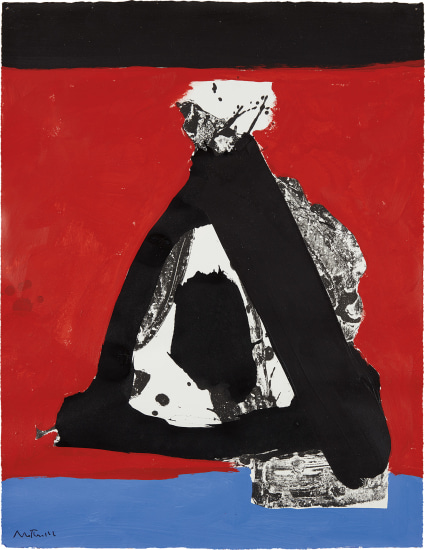
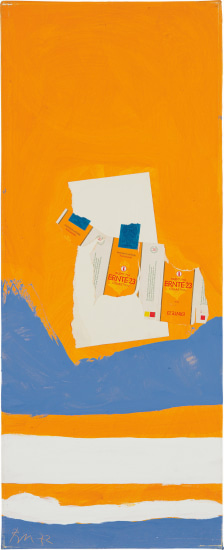

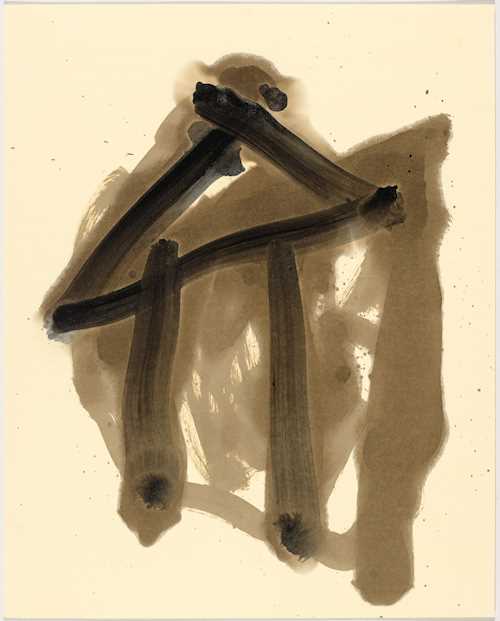

.jpg)

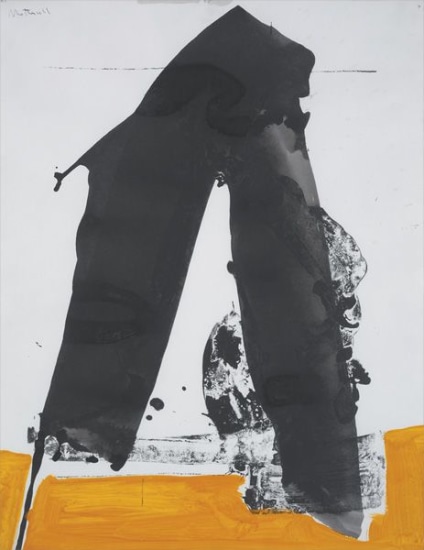
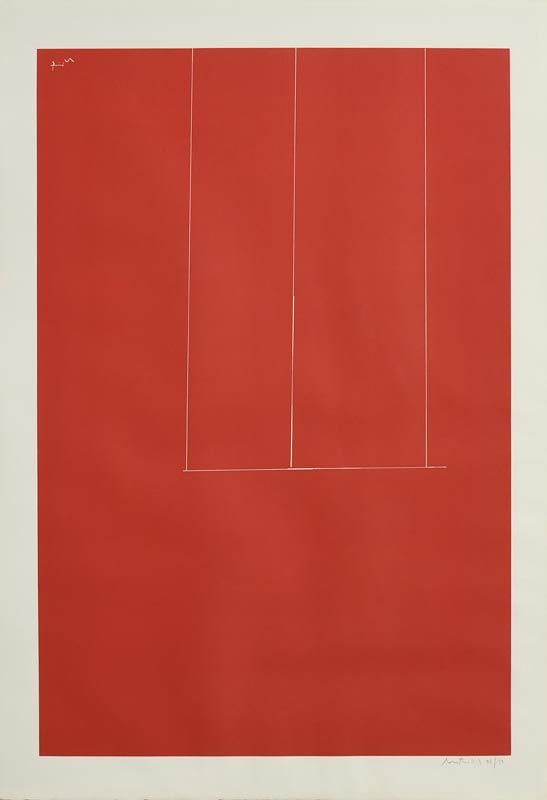
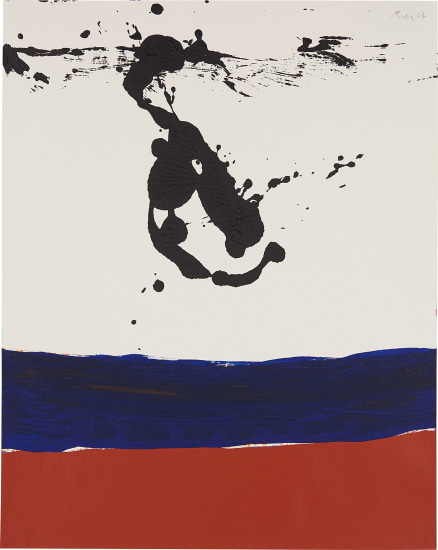
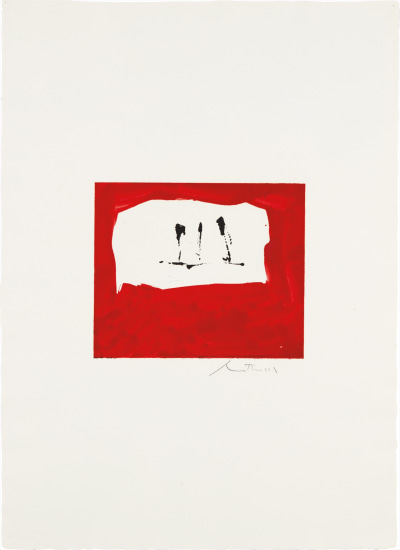
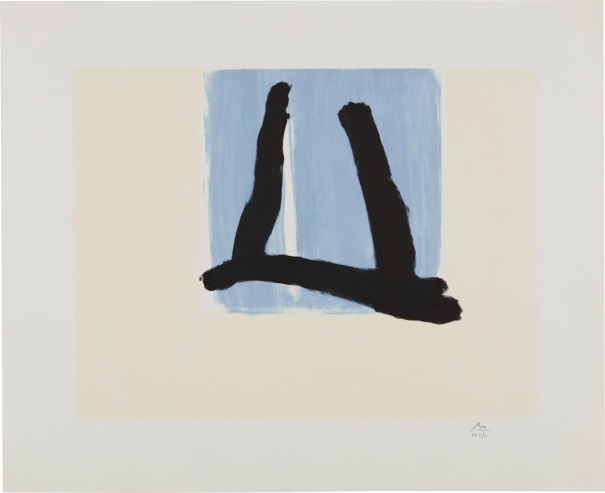
.jpg)

Testen Sie LotSearch und seine Premium-Features 7 Tage - ohne Kosten!
Lassen Sie sich automatisch über neue Objekte in kommenden Auktionen benachrichtigen.
Suchauftrag anlegen